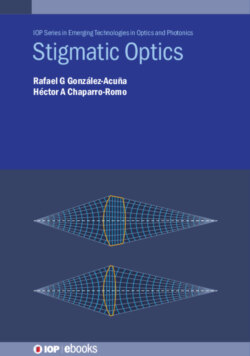Читать книгу Stigmatic Optics - Rafael G González-Acuña - Страница 24
На сайте Литреса книга снята с продажи.
1.11.2 Spherical coordinates
ОглавлениеNow let’s pay attention to the Helmholtz equation spherical coordinates. First let’s recall the Helmholtz equation,
∇2E⃗(r⃗)+k2E⃗(r⃗)=0.(1.53)
hence, in spherical coordinates the Helmholtz equation is expressed as,
1r2∂∂rr2∂E⃗(r⃗)∂r+k2E⃗(r⃗)=0.(1.54)
To solve it assume that E⃗(r⃗) has the following form,
E⃗(r⃗)=E′(r)reˆr(1.55)
where E′(r) is a function of r. Thus replacing equation (1.55) in equation (1.54),
1r2∂∂rr2−E′r2+r∂E′∂r+k2E′r=0(1.56)
expanding,
1r2−∂E′∂r+r∂2E′∂r2+∂E′∂r+k2E′r=0(1.57)
simplify,
1r∂2E′∂r2+k2E′r=0.(1.58)
Notice, that is the same equation that we solved in the previous section. Therefore, we can conclude that the solution of the wave equation in spherical coordinates has the following form,
E⃗(r⃗,t)=E0rcos(kz−wt).(1.59)
Notice that the amplitude of the wave decreases as r→∞.
As an exercise to the reader, please study the Helmholtz equation in cylindrical coordinates. The Helmholtz equation in cylindrical coordinates is the following expression,
1r∂∂rr∂E⃗(r⃗)∂r+k2E⃗(r⃗)=0.(1.60)
